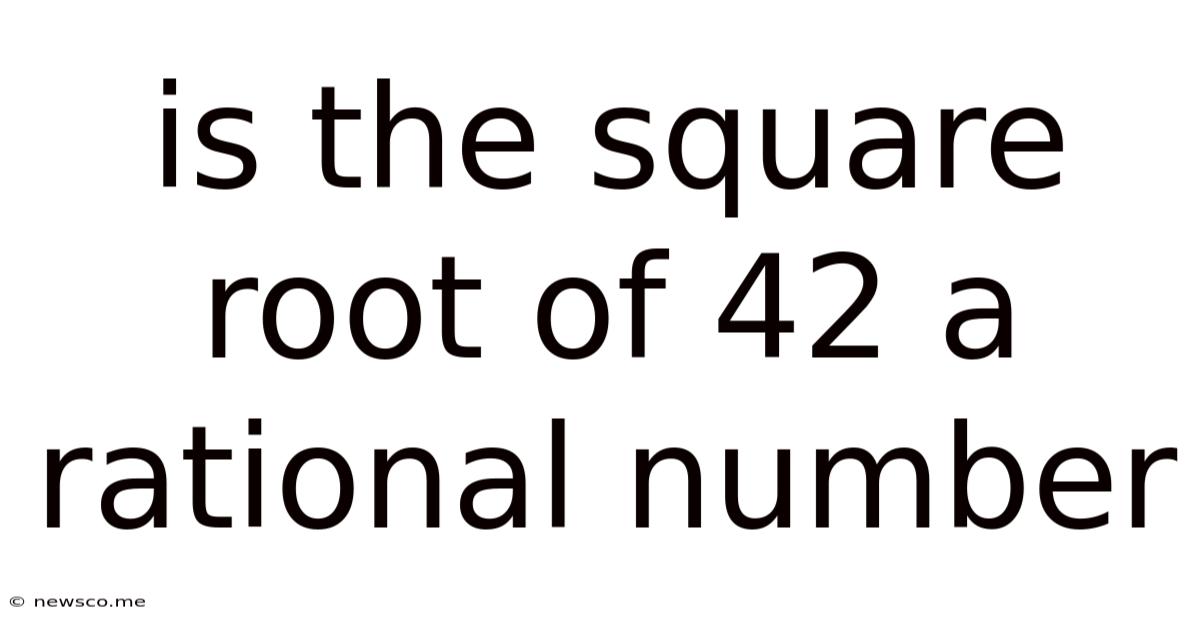Is The Square Root Of 42 A Rational Number
News Co
Apr 26, 2025 · 4 min read

Table of Contents
Is the Square Root of 42 a Rational Number? A Deep Dive into Irrationality
The question of whether the square root of 42 is a rational number is a fundamental one in mathematics, touching upon the core concepts of number theory and algebra. The answer, as we'll explore in detail, is a resounding no. But understanding why requires delving into the definitions of rational and irrational numbers, exploring prime factorization, and examining proof techniques. This article will provide a comprehensive exploration of this topic, suitable for both beginners and those seeking a deeper understanding.
Understanding Rational and Irrational Numbers
Before we tackle the square root of 42, let's define our terms:
Rational Numbers: A rational number is any number that can be expressed as a fraction p/q, where p and q are integers, and q is not equal to zero. Examples include 1/2, 3/4, -5/7, and even integers like 4 (which can be expressed as 4/1). The decimal representation of a rational number will either terminate (e.g., 1/4 = 0.25) or have a repeating pattern (e.g., 1/3 = 0.333...).
Irrational Numbers: An irrational number is a number that cannot be expressed as a fraction of two integers. Their decimal representation is non-terminating and non-repeating. Famous examples include π (pi), e (Euler's number), and the square root of most non-perfect squares.
Prime Factorization and Perfect Squares
The key to determining whether the square root of a number is rational lies in its prime factorization. A perfect square is a number that can be obtained by squaring an integer. For example, 9 is a perfect square (3² = 9), as is 16 (4² = 16), and 25 (5² = 25). Crucially, the prime factorization of a perfect square will always contain even powers of each prime factor.
Let's illustrate this:
- 9: Prime factorization is 3². The exponent (2) is even.
- 16: Prime factorization is 2⁴. The exponent (4) is even.
- 25: Prime factorization is 5². The exponent (2) is even.
If a number's prime factorization contains at least one prime factor with an odd exponent, its square root will be irrational.
The Prime Factorization of 42
Now let's examine the prime factorization of 42:
42 = 2 x 3 x 7
Notice that each prime factor (2, 3, and 7) has an exponent of 1, which is an odd number.
Proof by Contradiction: Why √42 is Irrational
We can rigorously prove that √42 is irrational using proof by contradiction. This method assumes the opposite of what we want to prove and then shows that this assumption leads to a contradiction, thus proving the original statement.
1. Assumption: Let's assume, for the sake of contradiction, that √42 is rational. This means it can be expressed as a fraction p/q, where p and q are integers, q ≠ 0, and p and q are coprime (meaning they share no common factors other than 1).
2. Squaring both sides: If √42 = p/q, then squaring both sides gives us:
42 = p²/q²
3. Rearranging the equation: Multiplying both sides by q² gives:
42*q² = p²
4. Deduction about p: This equation tells us that p² is divisible by 42. Since 42 = 2 x 3 x 7, p² must be divisible by 2, 3, and 7. Because p² is divisible by these primes, p itself must also be divisible by 2, 3, and 7 (if p wasn't divisible by 2, 3, or 7, then p² wouldn't be either).
5. Rewriting p: We can express p as:
p = 2 x 3 x 7 x k = 42k, where k is an integer.
6. Substituting and simplifying: Substituting this expression for p back into the equation 42*q² = p², we get:
42q² = (42k)² 42q² = 42²k² q² = 42*k²
7. Deduction about q: This equation shows that q² is also divisible by 42, and therefore q must be divisible by 2, 3, and 7.
8. Contradiction: We've now shown that both p and q are divisible by 2, 3, and 7. This contradicts our initial assumption that p and q are coprime (they share no common factors other than 1).
9. Conclusion: Because our initial assumption leads to a contradiction, the assumption must be false. Therefore, √42 cannot be expressed as a fraction of two integers, and it is irrational.
Further Exploration: Approximating Irrational Numbers
While we can't express √42 as a simple fraction, we can approximate its value using various methods:
- Calculators: A calculator will give you a decimal approximation (approximately 6.48074).
- Babylonian Method (or Heron's Method): This iterative method provides increasingly accurate approximations of square roots.
The irrationality of √42 highlights the richness and complexity of the number system. Understanding the distinction between rational and irrational numbers is fundamental to advanced mathematical concepts. This detailed exploration, combining definitions, prime factorization analysis, and a formal proof, provides a comprehensive understanding of why the square root of 42 is, indeed, irrational. The exploration of approximating irrational numbers further solidifies our understanding of the practical implications of this mathematical property. This thorough analysis allows for a firm grasp of the subject matter, catering to both introductory and advanced learners.
Latest Posts
Related Post
Thank you for visiting our website which covers about Is The Square Root Of 42 A Rational Number . We hope the information provided has been useful to you. Feel free to contact us if you have any questions or need further assistance. See you next time and don't miss to bookmark.